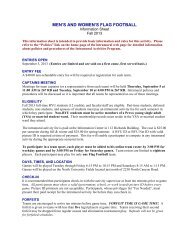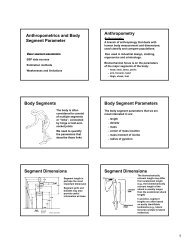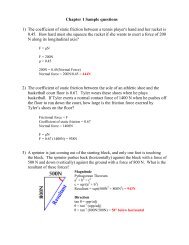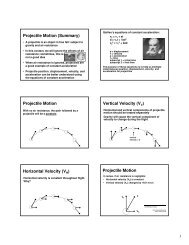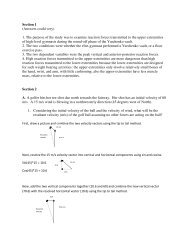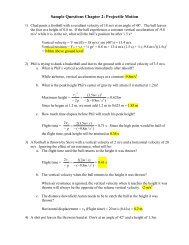Anthropometrics/Body Segment Parameters
Anthropometrics/Body Segment Parameters
Anthropometrics/Body Segment Parameters
Create successful ePaper yourself
Turn your PDF publications into a flip-book with our unique Google optimized e-Paper software.
Parallel Axis Theorem<br />
• Moment of inertia values are commonly<br />
specified relative to an axis through the<br />
segment center of mass<br />
• The moment of inertia about a different axis<br />
(e.g., through the proximal joint) can be<br />
determined using the parallel axis theorem<br />
I A = I CM + md 2<br />
Where I A is moment of inertia about the new axis, I CM is<br />
moment of inertia about an axis through the CM, m is<br />
segment mass, and d is distance between the two axes<br />
Parallel Axis Theorem<br />
A prosthetic lower leg has a mass of 3 kg and<br />
a center of mass 20 cm from the knee joint.<br />
The radius of gyration is 14.1 cm. What is the<br />
moment of inertia about the knee joint (I KNEE )?<br />
I CM = mk 2<br />
I CM = (3 kg)(0.141 m) 2 = 0.06 kg⋅m 2<br />
I KNEE = I CM + md 2<br />
I KNEE = 0.06 kg⋅m 2 + (3 kg)(0.2 m) 2 = 0.18<br />
kg⋅m 2<br />
Parallel Axis Theorem<br />
The combined moment of inertia<br />
of several segments about a<br />
remote axis can be calculated by<br />
using the parallel axis theorem,<br />
and summing across segments<br />
I LEG(HIP) = I T(HIP) + I S(HIP) + I F(HIP)<br />
where:<br />
I T(HIP) = I T(CM) + m T d T<br />
2<br />
I S(HIP) = I S(CM) + m S d S<br />
2<br />
I F(HIP) = I F(CM) + m F d F<br />
2<br />
Hip<br />
d F<br />
d S<br />
d T<br />
m F<br />
m T<br />
m S<br />
<strong>Body</strong> segment parameter<br />
assumptions<br />
During the period of data collection:<br />
• The segments are perfectly rigid<br />
• The segments are connect by frictionless<br />
hinge or ball-and-socket joints<br />
• The length of each segment remains constant<br />
• The CM location of each segment remains<br />
constant<br />
• The mass moment of inertia of each segment<br />
remains constant<br />
BSP Studies/Data<br />
Harless (1860)<br />
– One of the earliest quantitative study of BSPs<br />
– Dissected 2 cadavers (former prisoners who had<br />
recently been decapitated)<br />
– Determined segment mass & CM locations<br />
Braun & Fischer (1889)<br />
– Determined BSPs in 3 cadaver specimens<br />
– Divided body into 14 segments<br />
– Used data from individual segments to determine<br />
center of gravity of whole body during locomotion<br />
BSP Studies/Data<br />
Dempster (1955)<br />
– Did most detailed and extensive dissection to<br />
date in 8 cadavers specimens<br />
– Determined mass, CM location, & moment of<br />
inertia values for all major body segments<br />
– Expressed data as proportion of total body mass,<br />
and relative to segment lengths<br />
– Results have been used extensively in<br />
biomechanics research<br />
– However, data were from only 8 cadavers, who<br />
were older (52-83 yrs), Caucasian males, most of<br />
whom were reported to be emaciated<br />
4




